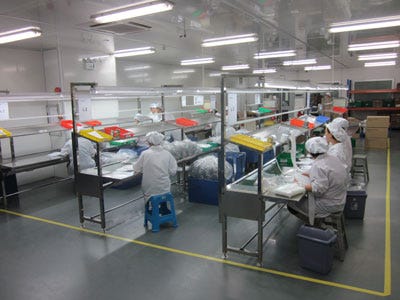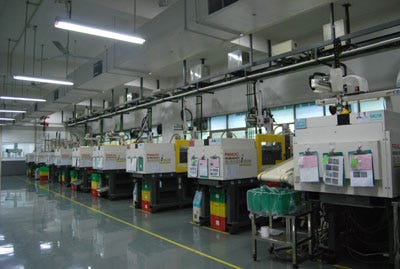June 23, 2015
Offshore, reshore, onshore, nearshore, or right-shore... It says something that so many different terms have popped up reflecting the complexity of modern globalized manufacturing operations.
Brian Buntz
|
GW says that companies that offer a standardized global manufacturing platform and quality system can take much of the risk out of offshoring. Shown here is the company's facility in Dongguan, China. |
A decade or two ago, many U.S. companies were tempted by seemingly simple arithmetic to move manufacturing operations from the United States to countries like China.
Things are more complex now, and much of the press coverage related to reshoring vs. offshoring fails to capture the nuances involved in the complicated calculus of deciding where to make what, says Ben Bouchard, vice president, international business development and managing director, China at GW Plastics (Bethel, VT). "As with most complex issues, it is tough to summarize the situation in a single headline," he says. "There continue to be examples of products moving both ways, and this will persist as markets develop and technology is applied."
GW Plastics continues to see an advantage of offshore manufacturing when manual operations or assembly are required. "We have also seen the cost advantage of China tool builds decline with higher cavitation molds, which can be produced with a higher level of automation for repetitive actions in U.S. tool shops," Bouchard says.
Bouchard notes that most of GW Plastics' customers have multi-national manufacturing and sales efforts so they are looking for suppliers that can support their products across the globe. "Fewer products are designed or distributed with only one global region in mind," he explains.
In the following Q&A, Bouchard reflects on GW Plastics' experience manufacturing goods in various locations across the globe, and provides advice that is applicable no matter where a company's manufacturing operations takes place.
Qmed: When does it make the most sense for a medical device company to move production to a destination like China versus locating it within the United States?
Bouchard: GW Plastics is committed to a NAFTA footprint and most of our production capacity is in North America but we are seeing significant growth opportunities in Asia as this market develops. In addition, we also see opportunities to supply Europe and India from a China manufacturing location. As far as when to consider China, it depends on the amount of labor required in the device manufacturing process, the points of distribution, and what region represents the expected growth opportunity in the future.
Qmed: What are the main challenges of doing production work (such as molding or contract manufacturing) abroad and how do you recommend overcoming them?
Bouchard: It is important to have a clear understanding of expectations and specifications. You also need to carefully choose the right partner. For example, there is a much wider range of company capabilities in China than in the United States and working with the right partner is the key to success. Companies like GW who offer a highly standardized global manufacturing platform and quality system can take much of the risk out of sourcing offshore.
|
Bouchard expects to see production continue to move to Asia as the Chinese medical device market grows. Above, a line of Fanuc Roboshot machines shown in the company's facility in Dongguan, China. |
Qmed: What in particular should medical device companies do to get the most out of outsourcing to Mexico?
Bouchard: Mexico has some unique advantages and challenges. The proximity to the United States is a great advantage, however, most medical companies appear to be located near the U.S. border rather than in the interior where there is more labor stability. Our plant is located in the beautiful city of Querétaro, which has proved to be an excellent location for manufacturers looking for a safe working environment with ample skilled labor, a strong educational system, and strong quality of life. We have healthcare-related business in this plant and hope to support more in the near future.
Qmed: Would you be willing to share a prediction of what you see happening with contract manufacturing in the next 5-10 years?
Bouchard: I would expect to see more production move to Asia as the products mature and the China domestic market expands. We are seeing great interest in diabetes, hypertensive, and respiratory treatment device growth in China (and India) and many companies see a future where the usage volumes for these treatments surpass the U.S. market.
As stated above, it does not make sense for all contract manufacturing to move to offshore. The decision will depend on both the economics of manufacturing as well as the economics of product distribution and regional growth expectations.
Learn more about contract manufacturing at MEDevice San Diego, September 1-2, 2015. |
Like what you're reading? Subscribe to our daily e-newsletter.
About the Author(s)
You May Also Like




